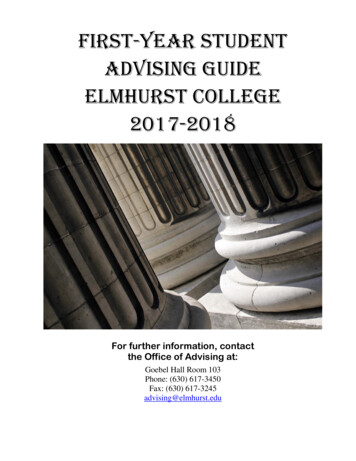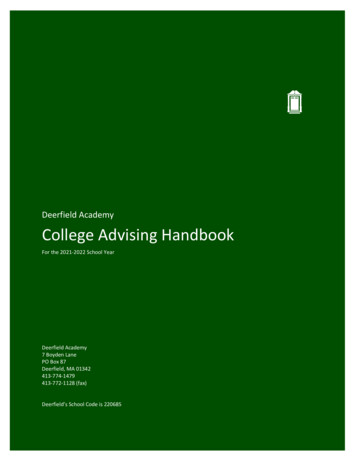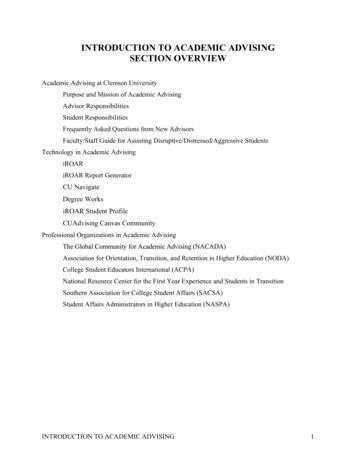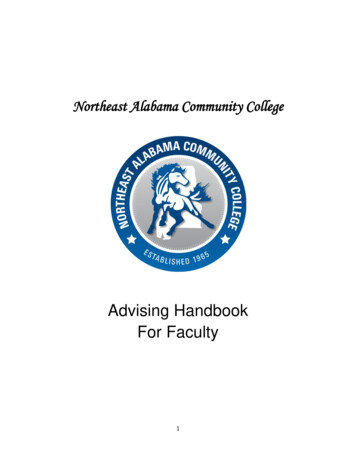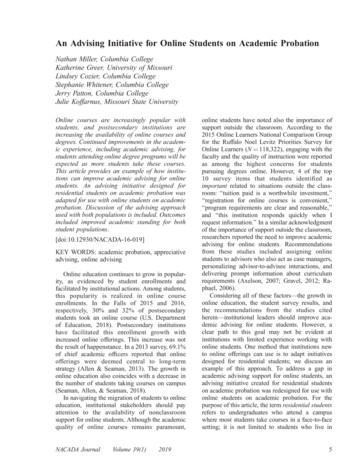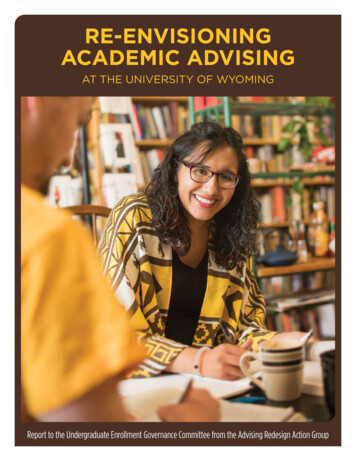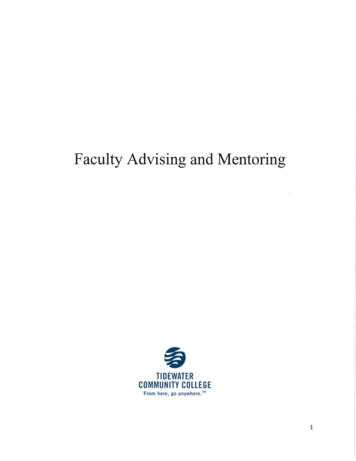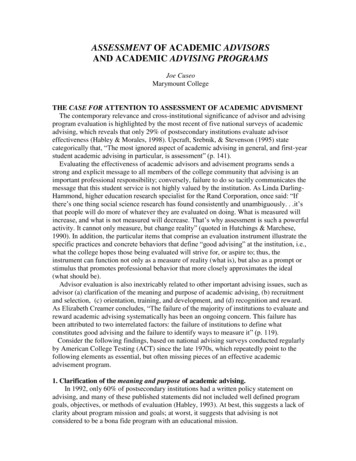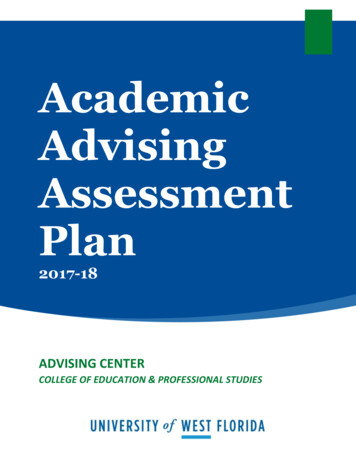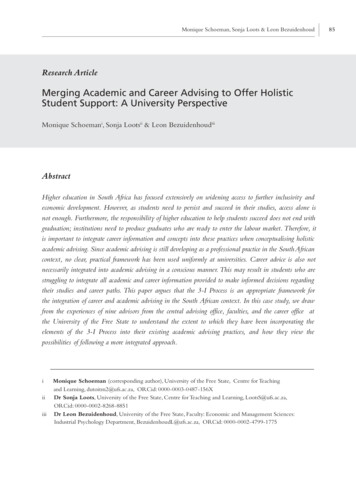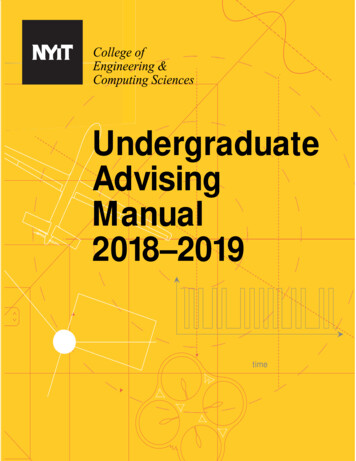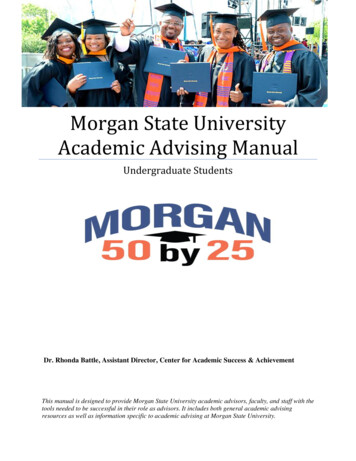
Transcription
Information and Advising: Helping StudentsNavigate Postsecondary EducationTechnical Working Group Summary July 26, 2019A Publication of the National Center for Education Research at IESU.S. DEPARTMENT OF EDUCATION
Information and Advising: Helping StudentsNavigate Postsecondary EducationTechnical Working Group (TWG) MeetingJuly 26, 2019National Center for Education ResearchInstitute of Education SciencesU.S. Department of EducationWashington, DCThis meeting summary was prepared by James Benson of the National Center for EducationResearch (NCER), Institute of Education Sciences, drawing upon presentation slides andrevisions from presenters, prepared and handwritten notes from Robin Pu Yigh (undercontract to NCER), as well as handwritten notes and revisions from Elizabeth Albro,Commissioner of NCER. The views expressed in this document reflect individual andcollective opinions and judgments of the presenters and participants at the meeting and arenot necessarily those of the Institute of Education Sciences or the U.S. Department ofEducation.
Table of ContentsTechnical Working Group Members . 1Invited Experts . 1Institute of Education Sciences Staff . 2Introduction . 3Motivation for and Organization of the Meeting. 4Session 1: Modeling Information and Advising within the College Attainment Process . 6Introductory Presentation: Introducing a Postsecondary Attainment Model . 6Figure 1. Framework for College Student Success . 8Panel Discussion . 8Framework for community college student success . 8The current context of advising. 9Implications for research . 9Session 2: Nudges and Light-touch Informational Interventions . 10Introductory presentation #1: The Remarkable Unresponsiveness of College Students toNudging and What We Can Learn from It . 10Introductory Presentation #2: The State of the Art of Nudging Students to PostsecondarySuccess . 11Panel Discussion . 13The role of trust in advising . 13Tensions between light-touch interventions and the need for sustained support . 13How can we determine what and when to nudge/intervene?. 14Next steps for research related to light-touch interventions . 14Session 3: More Intensively Engaging Students through Advising and Coaching. 16Introductory presentation: In-Person Advising: A Really Rough Look . 16Panel Discussion . 18Who is providing advice? . 18Identifying who needs help and understanding why they aren’t obtaining it . 18Considerations for implementing and testing intensive advising models. 19Session 4: Hybrid and Comprehensive Intervention Strategies . 20Introductory presentation #1: The Evolution of Technology-Enabled Advising . 20
Introductory presentation #2: Using Information and Advising within ComprehensiveStrategies to Promote Postsecondary Success . 21Panel Discussion . 23How can we improve participation in advising? . 23Integrating career planning with advising . 23Session 5: Bringing it all Together, and Next Steps . 25Support research on strategies to drive institutional change . 25Support qualitative research to understand students and how they respond toinformation and advising . 25Develop and test strategies for helping students to persist. 25Support replications of promising strategies . 26Appendix: Meeting Agenda . 27References . 28
Technical Working Group MembersInvited ExpertsChristopher Avery, Professor of Public PolicyHarvard UniversityBeth Bean, Vice President for National Engagement, Philanthropy, and PolicyStrada Education NetworkEric Bettinger, Associate Professor of EconomicsStanford Graduate School of EducationJerel Booker, Assistant Commissioner for College Readiness and SuccessTexas Higher Education Coordinating BoardCatherine Finnegan, Assistant Vice Chancellor for Institutional EffectivenessVirginia's Community CollegesMei-Yen Ireland, Program OfficerBill & Melinda Gates FoundationJennifer Keup, Director - National Resource Center for The First-Year Experience andStudents in TransitionUniversity of South CarolinaHana Lahr, Senior Research Associate - Community College Research CenterTeachers College, Columbia UniversityAlex Mayer, Deputy DirectorMDRCTrey Miller, Principal ResearcherAmerican Institutes for ResearchJoe O’Shea, Assistant Provost and Assistant Vice President for Academic AffairsFlorida State UniversityPhilip Oreopoulos, Professor of Economics and Public PolicyUniversity of TorontoLindsay Page, Associate ProfessorUniversity of PittsburghLashawn Richburg-Hayes, Vice PresidentInsight Policy Research1
Institute of Education Sciences StaffMark Schneider, DirectorInstitute of Education SciencesElizabeth Albro, CommissionerNational Center for Education ResearchMatthew Soldner, CommissionerNational Center for Education Evaluation and Regional AssistanceAllen Ruby, Associate Commissioner of Policy and SystemsNational Center for Education ResearchMarsha Silverberg, Associate CommissionerNational Center for Education Evaluation and Regional AssistanceJames Benson, Program Officer – Postsecondary EducationNational Center for Education Research2
IntroductionThe college pipeline from start to finish is an extraordinarily complex process withnumerous decision points, options, and obstacles. Students from advantaged socialbackgrounds are more likely than their low-income peers to attend schools and collegesstaffed with advisers and support staff that have time and resources to assist them atchallenging junctures. They may also draw on relationships with family, adults in theircommunities, or knowledgeable peers for assistance in making navigation decisions. Forstudents without such supports, the “choice architecture,” (Thaler & Sunstein, 2008) maybecome so overwhelming that they respond to it by delaying decisions or making poorchoices that lead to sizable delays in their progression to degree. And as delays and mistakesaccrue, many students decide to leave college entirely. For these reasons postsecondaryresearchers have turned their attention to helping students navigate the college pipeline.While researchers and college administrators generally agree that high-quality advising canhelp students with navigational challenges, they are also aware of the substantialexpenditures required to drive down student-to-adviser ratios. Also, through research anddirect interactions with students, they are aware of the proliferation of communicationplatforms within which students send and receive information. Thus, over the last 10 yearsresearchers and administrators have sought to develop and test information and advisingstrategies that rely upon larger portions of technology relative to direct human contact. Onone end of the technology-contact spectrum, strategies such as one-way text-messaging relyprimarily on carefully constructed text messages to nudge students to carry out crucialcollege-going tasks. On the other end of the spectrum, high school advisers employ simpletext messages to reach out to students and schedule in-person meetings with them. In themiddle are technology-enabled advising strategies that leverage data sources andcommunication platforms to target students with a mix of automated and face-to-facecommunications.Although technology-centered strategies have shown promise for improving short-termoutcomes in small experimental studies, these results have often not generalized when takento scale. Moreover, little research has addressed key questions regarding effective mixturesof technology and face-to-face advising as well as feasible strategies for scaling enhancedinformation and advising strategies within colleges and postsecondary systems.On July 26, 2019, the National Center for Education Research (NCER) of the Institute ofEducation Sciences (IES) convened a group of experts to discuss the current state of the fieldof research and practice for helping students navigate through postsecondary education. Thedecision to convene the TWG reflects IES’s commitment to investing in research thatidentifies effective strategies for assisting the broad population of postsecondary studentsas they make their way through a sequence of stages from application to degree completion.The Panel Discussion centered on four topic areas:3
1. A framework for college attainment: modeling information and advising within thelarger set of supports for students throughout the college attainment process.2. Nudges and light-touch strategies: strengths and weaknesses of technologycentered means of delivering information such as text messaging and chat bots.3. Intensive engagement: strengths and weaknesses of directly engaging studentsthrough advising, coaching, and mentoring.4. Hybrid and Comprehensive strategies: the potential for combining technologycentered and direct engagement strategies, and of combining multiple interventionstrategies.Each session began with an invited presentation on results from current or recently fundedpostsecondary research followed by an open panel discussion. The meeting concluded witheach participant offering his or her primary recommendations to IES.This document summarizes each session within the meeting and intends to accuratelychronicle the main presentation and discussion points without gauging the extent ofconsensus or disagreement on each point. Each of the presenters as well as IES staff inattendance have reviewed the document for accuracy.Motivation for and Organization of the MeetingJames Benson; National Center for Education ResearchDr. Benson outlined the following main objectives for the meeting:1. To make sense of null findings from recent research on light-touch postsecondaryinterventions.2. To consider the benefits and costs of a range of information and advising strategiesfrom light-tough strategies that rely primarily on technology to more intensivestrategies that include direct human interaction and additional supports.3. To make recommendations for future research.Dr. Benson noted that findings from evaluations of light-touch informational interventionsshow inconsistent impacts, with some findings indicating null impacts. For example, in aninitial evaluation the Expanding College Opportunity intervention increased the rate atwhich high-achieving, low-income students enrolled in “peer” postsecondary institutionswith competitive graduation rates and instructional spending (Hoxby & Turner, 2013).However, a recent evaluation of a similar, scaled version of the intervention by College Boarddid not replicate the initial improvements in college enrollment quality (Gurantz et al., 2019).In the H&R Block FAFSA Experiment, the information-only arm did not improve studentoutcomes, whereas the FAFSA assistance treatment—which provided direct assistance tostudents or their parents in filing the FAFSA—produced substantial increases in FAFSAsubmission, college attendance, Pell Grant receipt, and subsequent persistence. (Bettinger etal., 2018).4
Although nudging has produced significant impacts on relatively contained objectives suchas reducing “summer melt” (Castleman & Page, 2015b), recent results from IES-fundedevaluations have not been promising. An IES-funded evaluation of financial aid nudges 1—delivered to students via text messages encouraging FAFSA resubmission—shows that thenudges led some students to resubmit their FAFSA earlier but did not increase the overallrate of FAFSA resubmission, the average amount of financial aid, or the length of enrollment(Page et al., 2019). The IES-funded evaluation of the Digital Messaging to Improve CollegeEnrollment and Success intervention 2—a college enrollment intervention delivered by textmessage with the offer of two-way text advising—shows no significant increases in SATtaking, FAFSA submission, or enrollment (Avery et al., 2020). Moreover, evaluations ofnudging interventions have yet to demonstrate positive impacts on degree completion (thelong-term outcome that we care about the most).Results from evaluations of interventions that more intensively engage students are morepromising than nudging findings. An evaluation of the InsideTrack intervention, whichprovides intensive, individualized coaching to students with associate and bachelor’s degreeintentions, demonstrates significant positive impacts on progression through the secondyear of college as well as degree completion (Bettinger & Baker, 2014). An IES-fundedevaluation of the SOURCE intervention, 3 a near-peer pre-college advising program for lowincome college-ready students in the Los Angeles Unified School District found significantincreases in college enrollment and attendance at selective institutions for students offeredthe program (Bos et al., 2012). However, the lower-cost virtual form of the intervention,implemented in the same district for the same student population, produced no meaningfulimpacts on student outcomes overall or for any subgroup (Phillips & Reber, 2019).Looking across postsecondary intervention strategies, Dr. Benson noted examples ofcomprehensive intervention strategies producing meaningful gains in key outcomes,including the Accelerated Study in Associate Programs (ASAP) program which producedlarge initial gains in degree completion and continued enrollment in the initial evaluationthat followed students for 3 years, and continues to show significant impacts at 6 years fromprogram entry (Weiss et al., 2019); and the Early College High School model, whichsignificantly increased college completion rates in an evaluation of students in high schoolsdispersed across five states (Song & Zeiser, 2019).This evaluation is funded through grant R305A160400.This evaluation was funded through grant R305A140121.3 This evaluation was funded through grant R305F05274.125
Session 1: Modeling Information and Advising within the CollegeAttainment ProcessIntroductory Presentation: Introducing a Postsecondary Attainment ModelDr. Trey Miller and Dr. Amy Feygin (American Institutes of Research)Dr. Miller provided an overview of the IES-funded College Completion Network, which bringstogether research teams focused on postsecondary student success strategies to share ideas,build new knowledge, conduct rigorous research, and disseminate their findings. Thenetwork lead coordinates these efforts and conducts research with input from the teams.This research will include a synthesis of findings from NCER-funded postsecondary researchas well as a “gap analysis” study that is currently underway. The gap analysis draws on twocomponent studies to identify gaps between completion-oriented research evidence andpractices: (1) a systematic review of evidence from quantitative evaluations of communitycollege policies, practices, and programs on student outcomes; and (2) a qualitative scan ofpolicies, practices, and programs that community colleges use to improve student outcomes.In developing their approach to conducting the gap analysis, the lead team—with input fromnetwork members—elaborated a framework for community college student success (seeFigure 1). The framework represents as rows the key functional areas that drive studentsuccess: information about students (row 1), information and advising (row 2), academicand nonacademic supports (row 3), integrated certificate and degree programs/pathways(row 4), and curriculum and instruction (row 5). The framework represents as columns thekey stages that students move through on their way from college entry to labor market entry,as follows: entry (column 1); progress (column 2); completion (column 3); and labor marketentry (column 4). To highlight the strong linkages between advising and other supports, thediagram groups these two functional areas together. All functional areas serve to support theoperation of integrated certificate and degree programs or pathways (row 4), which extendthrough all stages and terminate in academic and labor market success (column 5).The framework can be used to break interventions into specific tasks and functions andcharacterize them according to whether they comprise multiple functional areas. Some“isolated interventions” (Bailey, Jaggers, & Jenkins, 2015) like tutoring are housed solelywithin a single functional area. Research suggests that although they are helpful, isolatedinterventions rarely move the needle on completion on their own (ibid). Morecomprehensive interventions like the Integrated Planning and Advising for Student Success(iPASS) initiative or Guided Pathways (ibid) include the implementation of a range ofstrategies that involve cooperation and coordination between several or all functional areas.The overall quality of an intervention depends on the quality of its components and thelinkages between them. Institutions may seek to drive improvements in student outcomesby improving individual strategies they have in place and increasing integration betweenthem.6
Dr. Miller noted that the framework borrows from Completion by Design’s Loss/MomentumFramework, which depicts how different types of polices, practices, and programs have thepotential to influence student experiences at different points in time across students’trajectories through college, from application to completion (Rassen, Chaplot, Jenkins, &Johnstone, 2013). Many interventions target a specific phase in students’ trajectoriesthrough college, such as interventions at the entry stage that aim to decrease summer “melt”(Castleman & Page, 2015a) by nudging students who have been accepted to college to showup and begin attending classes. Other interventions such as iPASS address more than onephase and adapt to students’ changing advising needs as they progress through college.Finally, Dr. Miller noted that context and policy play an important role in determining theprocesses and interventions that institutions implement to support student success.Contextual factors, like the population from which an institution draws its students or theresources available to it, will shape the types of processes and interventions that aninstitution decides to implement to support student success. For example, an institution witha large proportion of financially disadvantaged students may prioritize the provision ofnonacademic supports and targeted financial aid over other interventions. Similarly, policiesthat are set outside of the institution’s control may alter the set of possible interventions aswell as incentives for implementing them. Although policy and context are important factors,they are not captured directly within the framework.7
Figure 1. Framework for College Student SuccessPanel DiscussionThe panel provided comments on the framework and the current context of advising withincampus support systems. They also discussed implications for research in the arena ofinformation and advising.Framework for community college student successPanelists agreed that pathways through college are often not linear. Students may stop andstart their progress several times. Older students may enter after many years of employment.Some panelists felt that the presented framework does not capture the fact that progress isoften non-linear and may happen over many years. In addition, some felt that the frameworkshould include arrows upward from academic and non-academic supports (row 3) toadvising (row 2) and should not consider academic advising as separate from other studentsupports.Panelists discussed that it may be useful to tailor supports and interventions for students atspecific milestones captured in the framework. For example, interventions should address8
the “last mile” problem (getting students from Progress to Completion). Looking atinstitutions with exemplary student supports, such as the Aspen Prize winners, could helpresearchers to identify promising strategies for moving students to completion. Panelistsalso suggested that analytic frameworks should consider students’ post-graduation goals inoperationalizing success and noted that launching from college to employment is a distinctphase of advancement (column 4). Some interventions target this phase specifically.The current context of advisingAdvising is the most-commonly-offered intervention, and its design varies across campuses.One panelist noted that it is often disconnected from other types of support, while anotherpointed to systems designed so that all staff serve as advisers. In some locations, advising ismoving toward a model of service for students within an area of study, rather than a generaldrop-in model for all students. This type of “caseload advising” allows more intentionalconnection with students and may improve responses to early alerts and nudging. Panelmembers noted difficulty in isolating components of advising for the purposes of evaluationand replication.Panelists also noted that the level of institutional support for advising affects salary levelsand staff turnover, which can affect advising quality. Advising can be an entry-level, lowwage job, but career ladders can provide an alternative. However, it is challenging torestructure institutions to require advisers to be more experienced with higher salaries. It isalso challenging to change advisers’ mindsets and expectations about their performance.Implications for researchPanelists discussed how the current context of advising affects carrying out high-qualitycausal research. In instances where all staff serve as advisers, researchers will have difficultyin identifying control groups and measuring service contrast when assessing advisinginterventions. When assessing intervention impacts, researchers should consider whetherparticipation in advising is voluntary or required. In addition, analysts should considerstudents’ motivations for participating in advising, and account for the reality that students’decisions are often driven by their need for financial aid. Knowing about students’ financialneeds can inform the design of successful advising interventions. Integration of financial aid,advising, and other supports is critical for college success, and research frameworks shouldreflect this.9
Session 2: Nudges and Light-touch Informational InterventionsIntroductory presentation #1: The Remarkable Unresponsiveness of College Studentsto Nudging and What We Can Learn from ItPhilip Oreopoulos, University of TorontoDr. Oreopoulos presented highlights of results from a series of evaluations of light-touchinterventions that he conducted over the period 2014-2018 among first-year economicsstudents at University of Toronto. The evaluations used an experimental design to test a setof light-touch intervention strategies that had shown promise in prior trials including goalsetting and mindset exercises, online coaching alone, online coaching with one-way texting,online coaching with two-way texting, and online and face-to-face coaching together.Students in the control group took an online personality test. Although the mindsetintervention was associated with a small improvement in first-semester grades, none of thelight-touch intervention strategies resulted in substantively meaningful improvements toacademic progress (credit attainment and persistence) through the third year of college, 4even among students more at risk of poor academic performance.The primary exception to the overall null findings comes from an evaluation of the onlineand face-to-face coaching combination, which is associated with a statistically significant andsubstantial increase in credits earned during the third year of college (1.4 credits, 0.74standard deviation units). The evaluation of this intervention included a small sample ofstudents, 5 and thus more research is needed to assess this combination of technology andhuman interaction. Of all the interventions tested, the online and face-to-face coachingcombination was also most consistently associated with measures of improved mentalhealth and satisfaction with college. These effects may be important. An increasing numberof administrators and policy makers are recognizing the value in addressing mental healthand well-being on campus, over and above the objective of improving academic outcomes.More research is needed to understand whether this intervention type can produceconsistent improvements in mental health and credit attainment, and if so, to identify themechanism for such improvements. Although this intervention was positively associatedwith improvements to students’ time management and study habits, it did not lead tosignificant increases in their average weekly study hours.The online coaching intervention and the online and one-way text coaching interventions producedstatistically significant but small increases in credits earned during the third year of college.5 Oreopoulos’ research team recruited large samples for the tests of online coaching (3,048 students),online with one-way text coaching (2,709 students), and online with two-way text coaching (5,298students). The sample for the online and face-to-face coaching test was small (90 students).410
Based on his own research and his interpretation of the research literature, Dr. Oreopoulosoffered the following recommendations for future research on information and advising: Nudging for 1-time actions holds more promise. We should use nudging becauseit is very cost-effective, although trying to influence continuous behaviors such asstudy habits is more challenging than trying to influence one-time actions such ascompleting an application or signing up for courses.Engage in qualitative research to help us better understand student decisionmaking. Often, students’ decision making does not seem to make sense when viewedthrough survey or administrative data but does make sense when interviewers heardirectly from students.Fund replication research. Replications should be used to assess the externalvalidity of social-psychological and behavioral interventions.Focus more on shoving and less on nudging. Mandating use of existing servicessuch as application assistance and advice, proactive tutoring and advising, andgreater career transition support could produce better student outcomes.Enhance college preparation programs. Researchers should work with high schooladministrators to improve college preparation programs in order to improve collegesuccess.Improve campus culture. Researchers should work with college administrators tofoster a campus culture of inclusiveness, care, and high expectations for students.Consider operational changes. Researchers and administrators should considerdeeper operational change such as improvements to teacher quality or pedagogy.Re-assess key outcomes. College success should not be defined solely by degreeattainment, or even grade achievement.
Research (NCER), Institute of Education Sciences, drawing upon slides and presentation . Support qualitative research to understand students and how they respond to . The college pipeline from start to finish is an extraordinarily complexprocess with numerous decision points, options, and obstacles. Students from advantaged social
